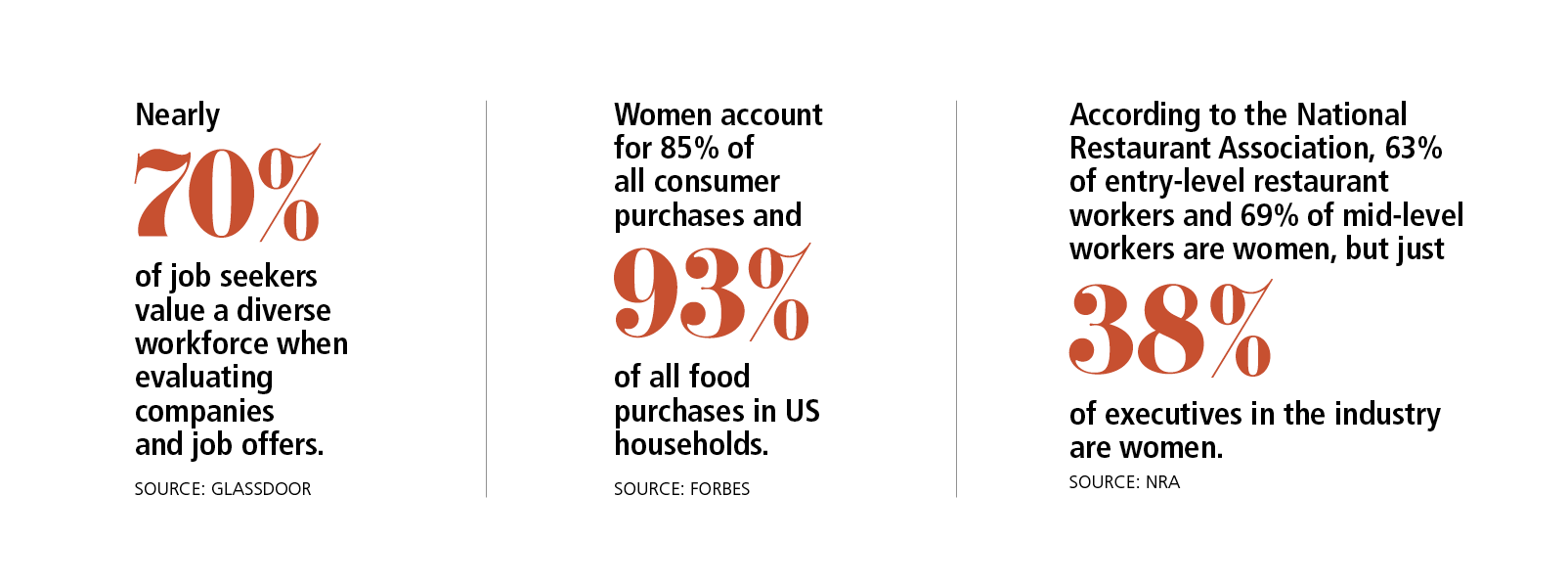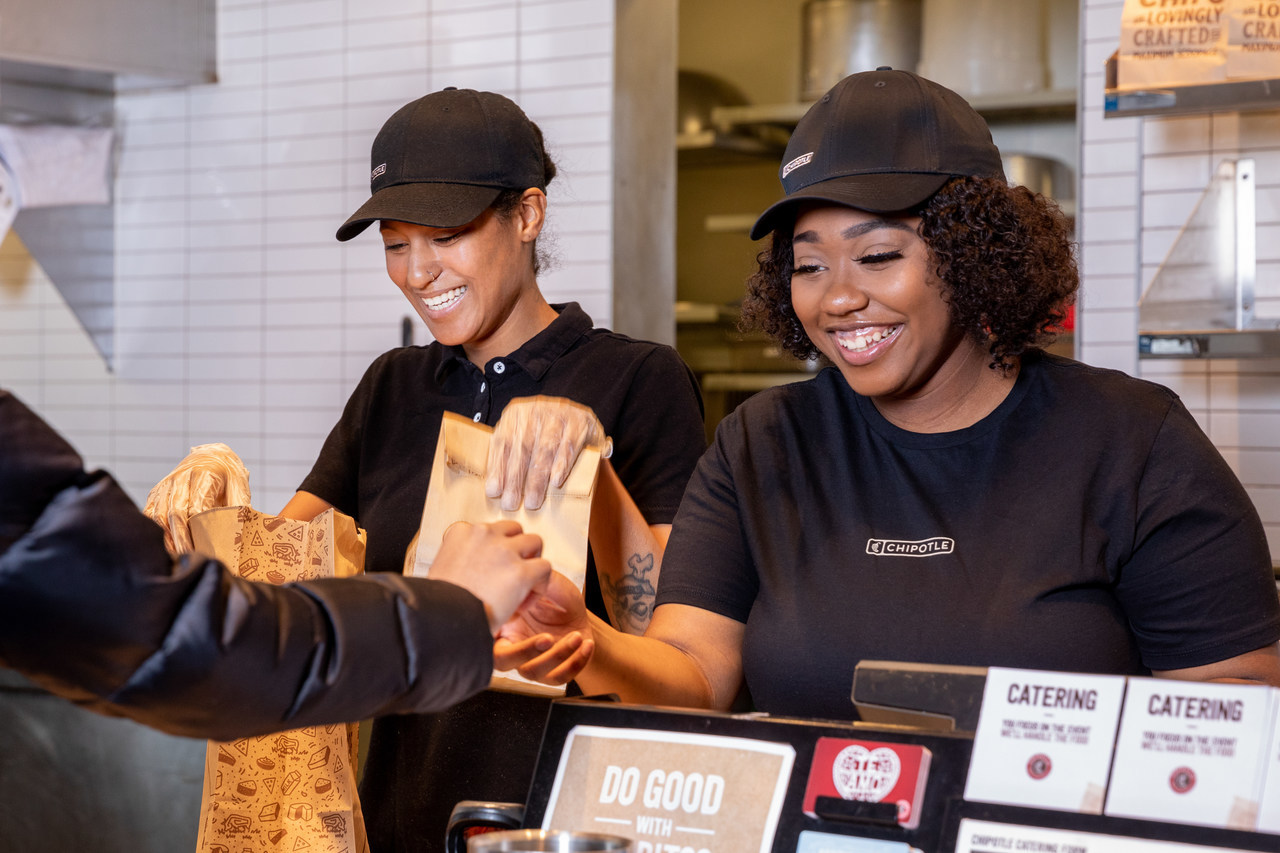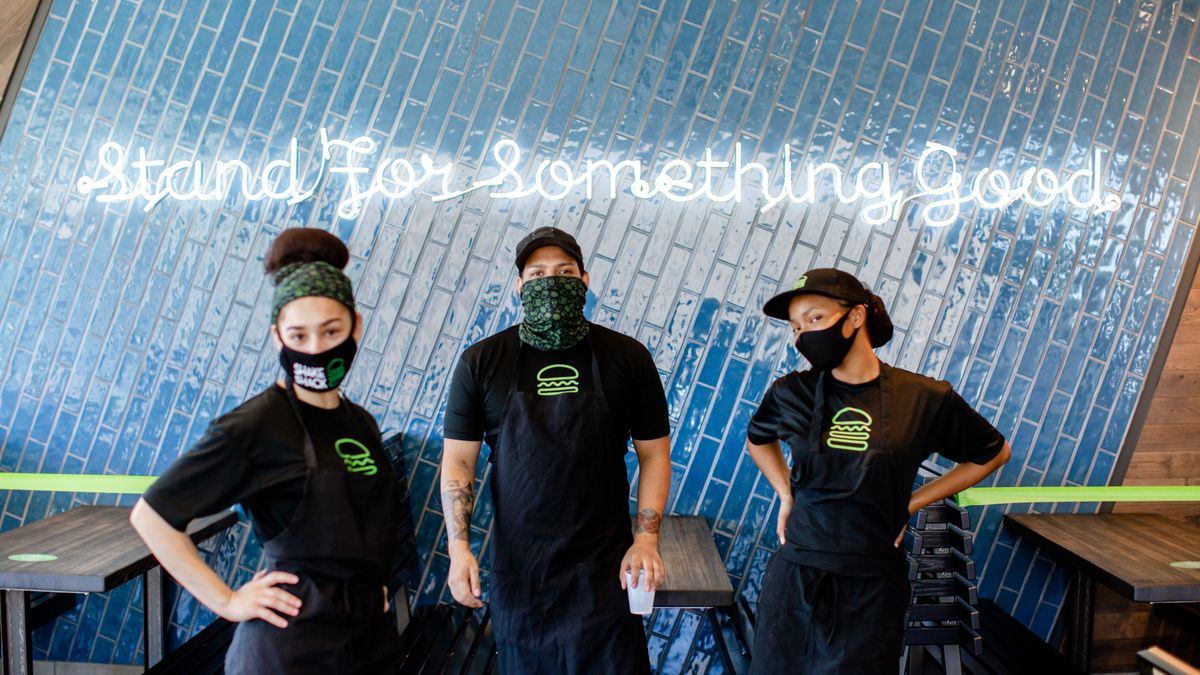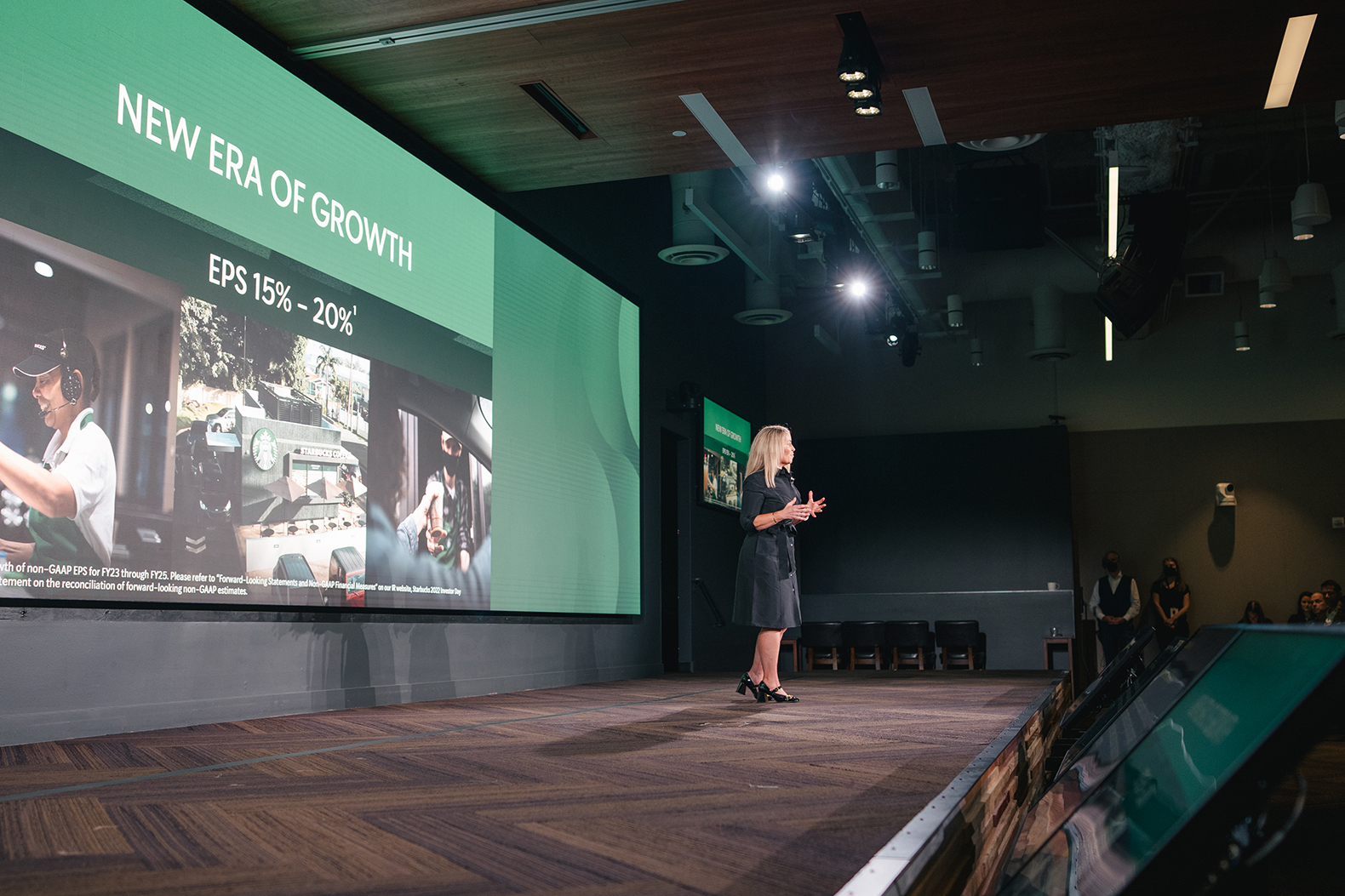The “Me Too” phrase was coined in 2006 to raise awareness about sexual abuse and harassment. In 2017, that phrase evolved into a movement sparked by a celebrity tweet encouraging women to come forward and talk about their own experiences. A hashtag moment swiftly went viral, and the conversation extended beyond social media all the way into corporate boardrooms, where leaders were faced with a daunting task of offering solutions.
The movement triggered a wake-up call in the restaurant industry, which — to be blunt — has a sexual harassment problem. According to the Harvard Business Review, as many as 90% of women in the industry have reported some form of sexual harassment, more than any other industry. That problem is exacerbated by a gap in representation (and decision making) among industry leaders.
Whether the industry has responded sufficiently since 2017 to close that gap depends on who you ask, but undeniably some progress has been made. Major restaurant companies have implemented new training and development opportunities, for instance, or added new policies for complaints and consequences. Others have started proactively prioritizing equal representation among decision makers, as well as pay equity among employees at all levels.
The demand for change exists. Women’s Foodservice Forum CEO Therese Gearhart said memberships and partnerships with her organization have “increased tremendously in the past two or three years.”
“How we’re being tapped into and how we’ve pivoted is a great signal in how our industry is engaging,” she said. “It’s a signal that the industry is clearly trying to deliver what employees need to thrive right now.”

Striving for pay parity
For starters, thriving means having a safe and supportive workplace, where employees believe they have an opportunity to grow and advance and that they are treated fairly. The fairness piece starts with equal pay for equal work. Starbucks is a bit of a pioneer here. In 2018, the company announced it achieved gender pay parity in the U.S. To do so, Starbucks began using an offer standards calculator based on experience versus geography or capability. The company also stopped considering compensation history.
Starbucks’ work opened the flood gates for other restaurant companies to strive for similar goals. In 2021, McDonald’s reported it closed all pay gaps by gender across its company-owned restaurants and corporate employees systemwide, for instance.
“We believe being transparent around pay practices helps battle inequity in the workforce,” said Heidi Capozzi, McDonald’s chief people officer. “Studies show that around the world, women in the workplace continue to be paid 20% less than men. Ending this gender pay gap is about making sure women and men are paid equally for the work they do, and it’s one way McDonald’s is leaning in to drive large-scale change.”
To be sure, pay parity is no small feat; according to the U.S. Census Bureau's American Community Survey, women earned an estimated 82 cents for every dollar that men earned in 2021. The gender pay gap was greater for full-time female managers, who earned an estimated 77 cents for every dollar earned by full-time male managers.

That said, several other brands have worked to close this gap as well, including Chipotle, which hired an independent firm to conduct a pay equity analysis last year and created a crew pay strategy “to ensure consistent and equitable pay decisions across the entire organization.” Yum Brands — parent company of KFC, Taco Bell, Pizza Hut and the Habit Burger Grill — also conducts an annual statistical analysis in the U.S. to confirm the company provides pay parity across genders and ethnicities.
These efforts are meaningful because they get the conversation started across the entire industry, said Maria Rivera, CEO of Smalls Sliders and former president of Krispy Kreme.
“When it comes to opportunities for women, having a clear path and a support system is critical, but there is also a level of investment that has to be made and that extends to pay parity,” she said. “Pay parity is still something nobody really talks about, but we have to talk about it, and we have to get to that point because that’s when we’re really treated the same.”
 Reaching representational equality
Reaching representational equality
Of course, pay is only part of the equality equation. Representation also matters, and major restaurant companies are pushing the gas on these efforts as well. Yum Brands joined the Paradigm for Parity Coalition in 2018, for instance, which strives to achieve gender equality in leadership roles. Yum has focused on coaching and sponsorship programs to reach this goal by 2030 and, in 2021, 42% of its global leadership roles were held by women.
In 2019, McDonald’s joined the fray, launching a program called “Better Together: Gender Balance & Diversity” aiming for improvement in gender representation by 2023. At that time, the company said 60% of its restaurant managers were women, while 30% of its officer positions were women. In 2021, CEO Chris Kempczinski updated the company’s goals to increase women in leadership roles from 37% to 45% globally by the end of 2025 and to reach gender parity by the end of 2030. As of the end of 2021, women held 41% of McDonald’s global leadership roles.
A McDonald’s spokesperson noted that each member of the senior leadership team has “taken ownership of this strategy by building an action plan within their respective function.” Further, McDonald’s has started tying executive compensation to representation metrics. Chipotle has recently done the same.
Still, despite corporate pledges and progress, just 38% of executives in the industry are women, according to the National Restaurant Association, while 63% of entry-level restaurant workers are women. Representation matters, but we’re not quite there yet. Not even close.
 How do we get there?
How do we get there?
So, how does the industry get there? Or at least closer? Beyond pledges — which are no doubt easier to execute for companies with deeper pockets, Rivera noted — it will require training and development opportunities, mentorship and support systems and, perhaps most importantly, the right benefits.
Yum Brands, for instance, has committed to adding 100 women and underrepresented franchisees by 2026. In doing so, the company launched the EmpowHER leadership development program to connect women leaders in franchise organizations across its four brands through development opportunities. The company also hosts inclusive leadership training and executive coaching opportunities, among other initiatives.
In 2021, Shake Shack piloted a women’s development program in partnership with Bonfire, a company focused on creating systemic change in the workplace.
“Their cohort experience prioritizes diversity and inclusion to create a powerful collective dynamic where women find a sense of belonging, a network for accountability, and a community for support and growth,” said Idris Stover, director of diversity, equity, inclusion and culture at Shake Shack.
The company has also held fireside chats with female board members to speak about their career journeys.
“Programs like these are key to ‘all-in’ on our diversity, equity and inclusion mission, and contribute to reaching our goals to increase the number of women and color in leadership positions in our Shacks by 2025,” Stover said. She added that of the 2,835 internal promotions in 2021, 56% went to women and 73% to people of color — almost double 2020 numbers.
 Most companies, including Noodles & Company., Yum and McDonald’s, have employee resource groups in place to create support networks. McDonald’s Global Women’s Leadership Network is the largest and only global enterprise ERG within the company, according to a spokesperson. Its mission is to “support a culture where women at all levels have equal opportunities to develop, advance and succeed.” In 2021, the GWLN doubled the numbers of chapters globally.
Most companies, including Noodles & Company., Yum and McDonald’s, have employee resource groups in place to create support networks. McDonald’s Global Women’s Leadership Network is the largest and only global enterprise ERG within the company, according to a spokesperson. Its mission is to “support a culture where women at all levels have equal opportunities to develop, advance and succeed.” In 2021, the GWLN doubled the numbers of chapters globally.
That demand for support is also illustrated with the Women’s Foodservice Forum’s participation growth in the past two years. Gearhart said the organization has developed monthly, hybrid, on-demand programming on topics that support women’s ongoing development, such as making your voice heard, advocating for yourself and self-care.
“Since Covid, we now have this place where we’re able to talk more often and more fluidly about topics that go beyond what we were maybe more limited to talk about in the past just at in-person events. The space provides an opportunity for them to find support and realize they’re not alone in what they need,” she said. “In the past two years, we’ve changed the way we’ve thought about what development includes. It’s more holistic now.”
That holistic approach also includes a sharper focus on mentorship. Gearhart said it’s important for WFF to provide regular access — through lunch-and-learns and other events — to female executives so that emerging leaders can hear their stories and see themselves on that path. Companies are also increasing such access internally. According to the Harvard Business Review, about 70% of Fortune 500 companies now have some type of mentorship program in place.
“Being a female in this industry is not easy and you have to align yourself with people who are going to support you along the way,” Rivera said. “I have been seen, heard and developed because I’ve worked with incredible mentors — male and female — who have pushed me to think beyond my own view of myself. I have to pay that forward and make sure I’m inspiring a new generation of female leaders.”

The benefits piece is where Noodles & Company has focused on closing the gap. According to Danielle Moore, director of communications, Noodles outperforms its peers when it comes to female representation; 50% of the company’s executives are women. While the chain does have a future leader development program, it’s not geared specifically toward women, nor does the company set targets for diversity.
“However, our focus is on equity and inclusion across our entire workforce, which positively impacts women. We create an environment where women can thrive,” she said, pointing to the company’s progressive benefits such as backup dependent care and tutoring services, free mental health counseling and free dental services for children under 14.
Such benefits are also why Starbucks has moved the needle on equity measures, offering paid sick time, family and medical leave, as well as 10 free days of childcare or eldercare through Care.com. According to Emily Williams Knight, CEO and president of the Texas Restaurant Association, childcare is the biggest puzzle piece that needs to be solved before true gender equity can be achieved in the industry. Not training, not resource groups, not development opportunities, but childcare.
“If we don’t figure this out — the unaffordable and inaccessible childcare issue — we can’t expect women to advance in our industry if they have or want to have children,” she said. “We can encourage them and mentor them and send them to every conference in the world, but if we don’t get the basic blocking and tackling down, we will not grow women leadership in this industry.”
 Knight's point became crystal clear during the throes of the pandemic, when millions of women left the workforce to care for their children as schools and daycares closed, according to the National Women’s Law Center. This trend, however, existed long before the pandemic. McKinsey and Co. reports that 25% of women with children considered leaving the workforce prior to 2020 because of familial obligations. The restaurant industry has typically presented more challenges than others when it comes to parental flexibility, given off-hour and weekend shifts.
Knight's point became crystal clear during the throes of the pandemic, when millions of women left the workforce to care for their children as schools and daycares closed, according to the National Women’s Law Center. This trend, however, existed long before the pandemic. McKinsey and Co. reports that 25% of women with children considered leaving the workforce prior to 2020 because of familial obligations. The restaurant industry has typically presented more challenges than others when it comes to parental flexibility, given off-hour and weekend shifts.
“Making progress here requires us to identify that it’s not a characteristic of women keeping them back, it’s the system they have to function in. If you look at the numbers, the childcare piece is so critical. Fundamentally, this limitation is an economic issue for the industry. Not a women’s issue; an economic issue,” Knight said. “After what we’ve learned from the pandemic, now is the time for us to get serious about how we take of our employees and their families.”
In October 2021, Texas walked the walk on this, launching a Service Industry Recovery Child Care program that promised a stipend paid directly to a childcare provider of the parent’s choice for workers employed in the service industry. The program also offers free childcare tuition scholarships for 12 months for those employees.
Some restaurant companies are also taking note. McDonald’s, for instance, recently made a multimillion-dollar investment to provide caregiver benefits, paid time off and more flexibility.
“We have created programs specifically designed to support women — the largest group within our workforce — as they continue to develop and grow their careers. Some of these efforts include launching a backup childcare program for both corporate staff and company-owned restaurant crew,” a McDonald’s spokesperson said. “We’ve seen great success in the U.S. and hope to eventually roll it out globally.”
Facing the biggest challenge: burnout
Where does this work go from here, especially as the Me Too catalyst has evolved beyond its top-of-mind viral moment? Equal leadership representation will likely help close the pay gap, and having major corporations drive the change here is a good place to start. Perhaps the next biggest challenge, then, is how to deter burnout. According to McKinsey, senior women leaders report significantly higher rates of burnout compared to men because they tend to bear the brunt of household and childcare work. An estimated 43% of women leaders feel burned out, versus 31% of men who are at the same level.
“One of the challenges that persists is the sheer burnout and exhaustion of women leaders who have only taken on more these past couple of years,” the WFF’s Gearhart said. “These are the women who are hopefully closing the gaps, so the industry has to continue to provide resources and tools to solve against that — things like flexible hours, benefits, trying to focus on more relevant topics to raise self-awareness and reflection, creating a community to connect with people going through similar experiences. Making sure these conversations and communities exist is a big help on that journey.”
Contact Alicia Kelso at [email protected]





